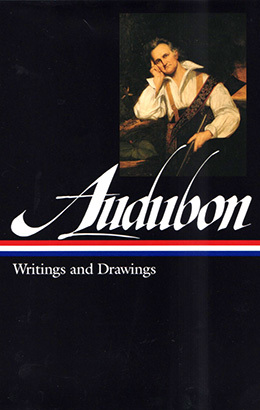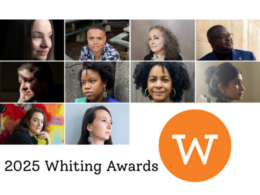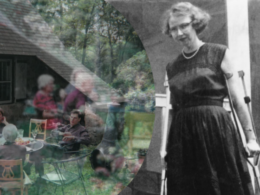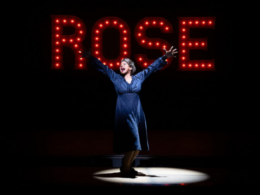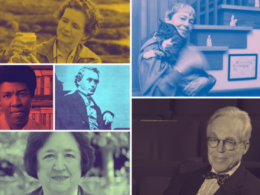Our latest guest post comes from Christoph Irmscher, distinguished professor of English at Indiana University Bloomington and the editor of the Library of America volume John James Audubon: Writings & Drawings (1999), the authoritative collection that gave, arguably for the first time, equal ranking to Audubon’s natural history writing and his visual art.
Irmscher extends his involvement with Audubon’s writing and painting with the release this month of Audubon at Sea: The Coastal and Transatlantic Adventures of John James Audubon (University of Chicago Press), an anthology he co-edited with Richard J. King that explores, in the publisher’s words, “Audubon’s diverse observations of the ocean, the coast, and their human and animal inhabitants.” Reviewing Audubon at Sea in the New York Review of Books, Jenny Uglow calls it “impeccably edited” and “captivating reading.”
In the following essay, Irmscher touches on some of the new book’s themes while also reflecting on what many consider to be Audubon’s increasingly fraught legacy.
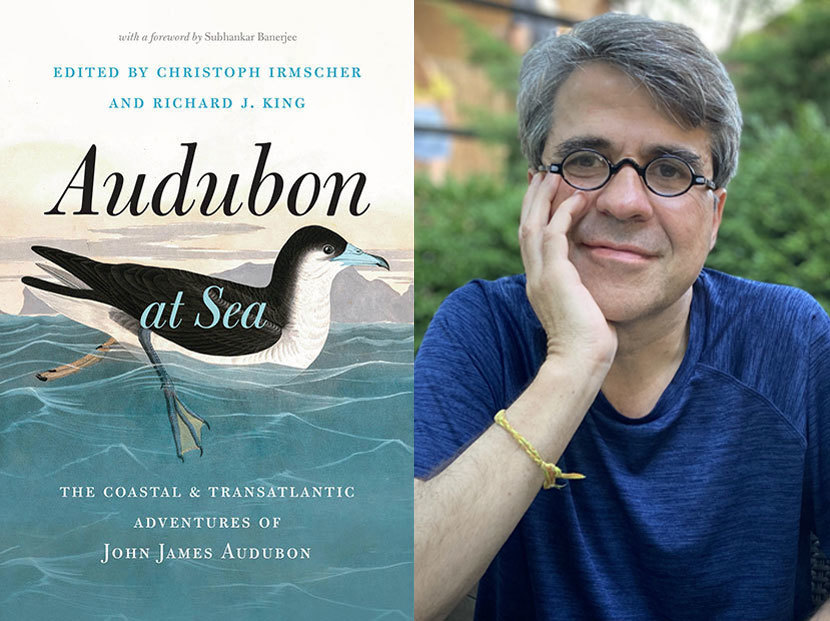
By Christoph Irmscher
John James Audubon (1785–1851) has always been a problematic hero. In his lifetime, he was attacked as an imposter and braggart, a con man who had neither the artistic nor the scientific credentials to back up the sweeping claims he made about American ornithology. After Audubon’s death, his granddaughter Maria, concerned about her ancestor‘s reputation, scrubbed his prose clean of references to drinking and sexual innuendo and destroyed many of his original journals, replacing them with her own sanitized versions. More recently, Audubon has come under fire again, with some demanding that the Audubon Society consider changing its name. He was never the St. Francis of the American bird world that some fans would like him to be. During four decades of fieldwork, he must have killed thousands of birds.
And that’s not where the problems end. The illegitimate son of a French sea captain and slave trader, Audubon also owned and sold enslaved people, whose share in his work he never acknowledged, although the attentive reader will notice glancing and often appreciative references to wilderness-savvy Black hunters he encountered during his travels in the South. In the eyes of some, Audubon’s racism also spills over into his work, the colonialist presumption that American nature is his to appropriate and turn into art, making it part of a long and painful legacy that has excluded naturalists of color from conversations about American nature. The rumor that he himself might have been Black (and in denial about his own heritage) has proved surprisingly stubborn, given the fact that there’s no supporting genealogical evidence.
Not unexpectedly, the defenders of Audubon have cried foul and worried that such revisionist approaches are intended to “cancel” him. Such worries seem unfounded, though; Audubon has already survived almost two hundred years of negative press, and his scientific and artistic afterlife likely does not depend on whether or not the Audubon Society continues to flaunt his name. In fact, the current critical discussion seems geared to remind us, once again, how complex Audubon is—and how that complexity also shapes his work.
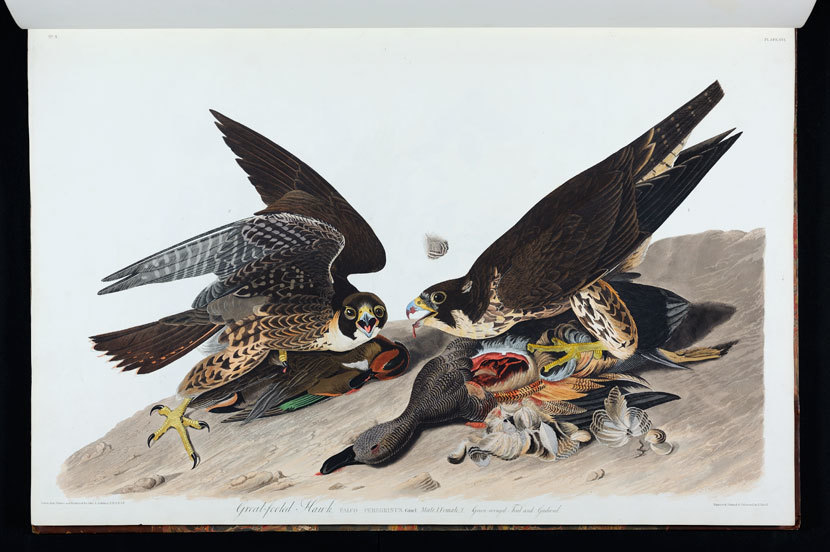
As Alan Braddock, an art historian at the College of William and Mary, likes to say, Audubon’s art turns heads—both the birds’ and ours. Many of Audubon’s plates are appalling rather than appealing. Consider the above representation of two peregrine falcons, an early plate in _The Birds of America (plate 16, 1827–1838). (The female on the right Audubon collected on Christmas Day, 1820, on his journey down the Mississippi River. He drew her in pastel over two days and later pasted her on a sheet next to a male bird he had shot near Niagara Falls in 1824.) Audubon knew the peregrine as the “Great-footed Hawk,” and the composition serves as an extended commentary on that name, since it draws attention to the bird’s extraordinarily powerful foot. The smaller male on the left is eviscerating a green-winged teal, while the larger female on the right is dripping with the blood of a gadwall she has slaughtered. The landscape is askew, sloping from right to left, which adds drama especially to the male’s pose: he is driving his talons into the dirt, as if wanting to keep himself from sliding down. His head is turned in the viewer’s direction, while the female is looking at the male. At the same time, both birds also appear to be looking at us. While Audubon, in the essay accompanying the plate, does not comment on what we would now call the peregrines’ binocular vision, his fieldwork would have given him an intuitive understanding of their extraordinary visual powers.
The gory world of the peregrines is decidedly not ours. (There’s no question that Audubon would have assumed his viewers to be white, mostly male, and, given the price of his plates, well-off.) In his essay, Audubon chooses anthropomorphic language precisely to highlight the difference between the world of the viewer and that of the birds, referring to the peregrines’ meal as a “brace of ducks” and their “dejeuné à la fourchette,” their warm (literally, “forked”) lunch And he adds a touch of irony to the print itself. In artworks, the center of a composition has vital importance—it organizes the scene that is represented, helping to balancing the various components. Audubon purposely troubles the viewer’s attempts to locate such a center. Is it the empty space between and above the beaks of the two birds? Or is it where that feather is drifting that seems to have detached itself from the gadwall’s body, its very lightness offering a contrast to the heaviness the plate depicts?
Sometimes Audubon’s birds look right past us. In his well-known depiction of two Snowy Owls (plate 121), Audubon offers another comment on the limits of human vision. While the female owl (the larger bird below) has her eyes trained on the viewer, the male is preoccupied with something of special interest happening to his left, outside the picture frame and definitely outside our field of vision—a subtle hint that the world inhabited by the owls is larger than our, the viewer’s, world. His plate acknowledges the viewer’s presence but transcends it—the male has more important business to take care of than subjecting himself to our scrutiny. What that business might be, we can’t know, and that’s exactly the point. This has long ceased to be a scientific illustration; it opens a window unto a world larger than that inhabited by the viewer.
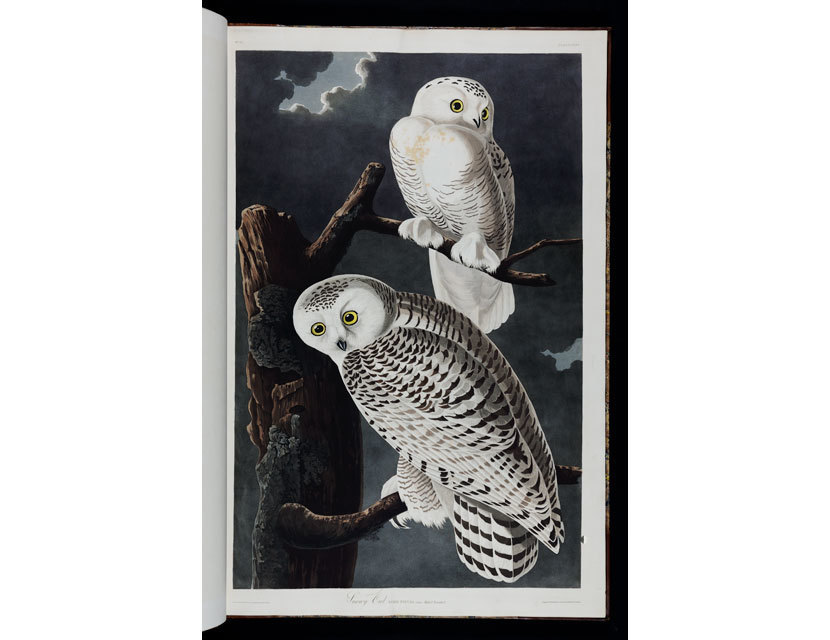
Audubon doesn’t exempt his own viewing (as manifested in his plates) from critique. Many of the plates—the “Great-footed Hawk” is no exception—feature birds with open beaks, caught in the act of screaming, calling, or singing. Yet, like the figures on John Keats’s Grecian urn—they are silent, piping “ditties of no tone.” When he was in Labrador, Audubon painted a pair of razorbills (below) in their spring plumage, drifting in a tranquil sea, cliffs rising in the background. Note the feet of the male on the right, treading the unrealistically transparent water. Unlike humans, these birds are comfortable both on the surface of the water and under it. Of course, it is scientifically useful to give viewers a glimpse of a bird’s feet, but Audubon also must have relished the stagey quality of the image he had fashioned. The female’s body on the left, tail pointed upwards at the sky, corresponds in outline to the top of the massive rock in the background on the right.
The only speck of strong color in this plate is the inside view of the female’s bill we get—Audubon’s way of drawing our attention to this extraordinary organ (whose structure he describes in great detail in the corresponding essay, from the white lines across the mandible to the “decurved” tip). Audubon characterizes the inside of the razorbill’s mouth as “gamboge-yellow,” a word rarefied enough to attract the same kind of attention in the text that the coloring of the inside of the bird’s mouth does in the plate. “Gamboge,” the source of a bright yellow pigment used by painters, is the gum-resin extracted from various trees of the genus Garcinia, cultivated throughout Southeast Asia. In this case, the dramatic color, since it’s so visible, only draws attention to what we can’t hear. Audubon’s birds speak—but they don’t speak to us.
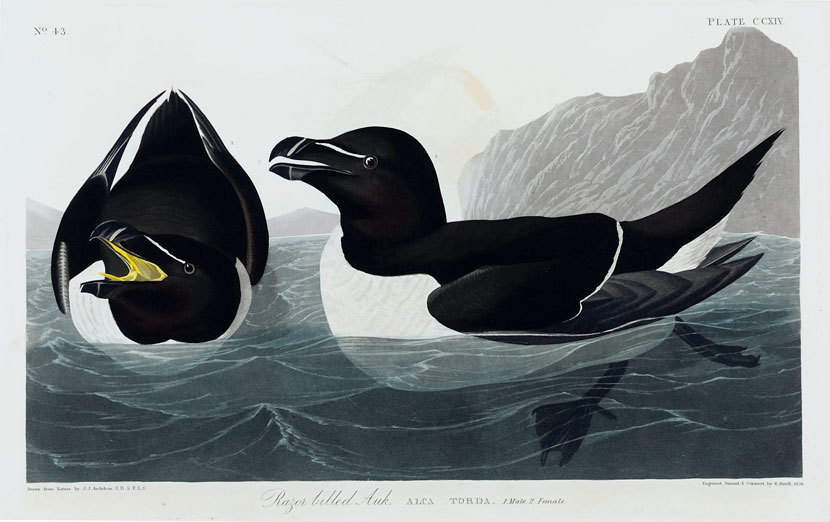
Sometimes the human world enters directly into Audubon’s plates, in the form of log cabins, distant farms, fence posts, or an old hat, used as nest by house wrens. One of the most spectacular images in The Birds of America is the Great White Heron (now generally accepted to be a color morph of the Great Blue Heron). Great Whites are known to swallow their prey alive, and the crouched position the bird assumes when feeding not only allows Audubon to fit this large bird into the limited space of his picture, it also gives him the chance show off his capacity for dark humor: the fish born aloft by the bird’s heavy bill, so evidently out of its element, displays a look of terrified surprise, its upturned darkening eye providing a sharp contrast with the fiercely yellow eye of the predator who seems to make sure that we are watching him.
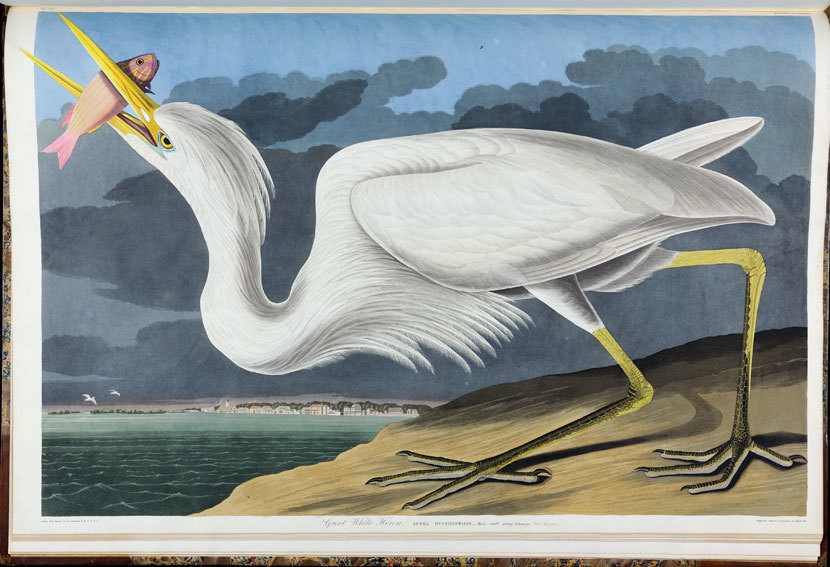
The series of tiny houses in the background —a view of Key West, Florida—serves as a mere backdrop for the main show acted out in the foreground, the savagely funny drama of death and survival. Audubon’s collaborator, the Charleston minister and naturalist John Bachman, tried to civilize these great birds and almost immediately, as Audubon gleefully reports, ran into serious trouble: they were hungry all the time (devouring a gallon of mullets in no time at all) and fiercely aggressive. They pursued Bachman’s chickens, gored his cat, and finally turned on his children. Bachman ordered them killed.
In his best work, Audubon’s birds stare back at the viewers and, inevitably, find them wanting. In Audubon’s landscapes, birds are the real residents and humans the interlopers, pushed to the margins, if they, or indices of their presence, are included at all. Especially today, when waterbirds like Audubon’s razorbills are facing a litany of threats ranging from habitat destruction to plastic in their food, Audubon’s art has an undeniable ecological edge. I am not suggesting that this redeems Audubon from his personal shortcomings. There is no doubt that he was deeply enmeshed in the limping, homicidal rawness that marked white antebellum America. But it is also possible that it was precisely that complicity that allowed him to see in his art, more clearly than many of his contemporaries, the limits of the white presumption (including Audubon’s own) to fully understand, know, own, and destroy the natural world. This might also be the “drama” the Black artist Kerry James Marshall (born 1955) noticed in Audubon’s work. One of Marshall’s best known riffs on Audubon, the painting Black and part Black Birds in America: (Crow, Goldfinch) (2020), features a large black crow perched on a leafy tree—entirely too large to be contained by the dainty, pathetic birdhouses, the unsuitable, exclusionary emblems of white ingenuity, precariously positioned behind it.
Christoph Irmscher directs the Wells Scholars Program at Indiana University Bloomington, where he is also distinguished professor of English. A regular book reviewer for The Wall Street Journal, he is the author of several books, including The Poetics of Natural History (revised edition, 2019); Max Eastman: A Life (2017); and Louis Agassiz: Creator of American Science (2013).
